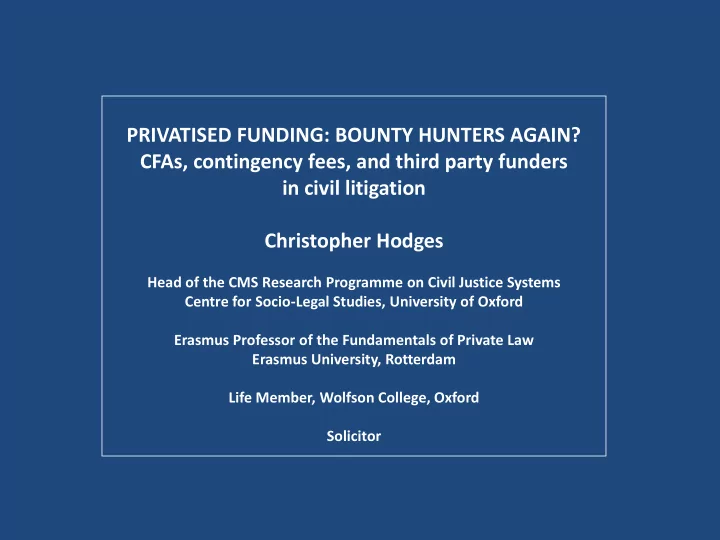

PRIVATISED FUNDING: BOUNTY HUNTERS AGAIN? CFAs, contingency fees, and third party funders in civil litigation Christopher Hodges Head of the CMS Research Programme on Civil Justice Systems Centre for Socio-Legal Studies, University of Oxford Erasmus Professor of the Fundamentals of Private Law Erasmus University, Rotterdam Life Member, Wolfson College, Oxford Solicitor
A Timeline of Litigation Funding in England & Wales • Personal assets • Trade Union • First Party Insurance: BTE LEI • Legal Aid, 1949-1995-2011 • CFA + ATE LEI: Conditional fee arrangement + after-the-event insurance, 1995-2011 • DBA: Damages-Based Agreement: 2011 • TPF: Third Party Litigation Funding: 2000s
Sources of Funding • Personal • Third Party • Cooperative • Trade Union • Bank • Insurer • State • Investor • Intermediary • Lawyer • Investor/Handler
The Legal Aid Welfare State Experiment Decisions on – Eligibility – Volume of supply Rights-based: control by suppliers co-payment Attempts to control: approved suppliers, budgets, fixed fees Protectionism: one-way cost shifting
CFAs • Basic fee + success fee (linked to risk) • Costs risk: ATE (expensive) • 1999 Woolf CPR: system favoured wealthy C • all 3 elements recoverable from D • Costs War • Claims Management Companies and abuse • 2007 Regulation
Jackson Costs Review 2010 • Costs still too high: multiple measures (QOCS) • CFA success fee and ATE premium should not be recoverable: come out of damages • MGN v UK ECHR • Further cut in Legal Aid • Funding has to go private: – BTE (but needs fixed costs) – Lawyers: DBAs or CFAs – Third Parties – SLAS/CLAF
DBAs • Contingency fees are banned in most of Europe • Political objections to ‘American contingency fees’: allegations of abuse • DBAs – not ‘contentious business’ so developed in tribunals, esp employment • 2010 regulation: fee<35% recovery
Growth of Third Party Funding • Germany • USA • Australia • Canada • UK • Other
Common law doctrines Maintenance: officious intermeddling in a suit, by maintaining or assisting a party with money Champerty: supporting a suit, financially or otherwise Barratry: stirring up a suit
Evolving attitudes • Criminal Law Act 1967 abolished the crimes and torts of maintenance and champerty • Still an illegal contract + risk of a costs order • CFAs made a statutory exception 1995
Germany • Predictable costs: tariff for court, lawyer and recoverability • Hence growth of (BTE) LEI insurance • Spread to companies (SMEs) • No rule on maintenance and champerty: contingency fees banned, success fees permitted
Private law enforcement in the US legal system: Encourage all to pursue breaches of public and private law • Wide investigation powers • No cost barriers • Cost incentives • Deterrent penalties Private attorneys general – bounty hunters Blackmail settlements?
USA • Loans to the poor: – consumer protection and abuse issues • Loans to law firms • Growth of investors: – large commercial claims
Australia • Class actions regime – representative P • TPF: Fostif 2006 ‘access to justice’ • A managed investment scheme subject to regulation? Brookfield Multiplex 2009 but .. • Assignment model: cover costs risk
EU LFs • Origins – International ECGD debt collection – Insolvency • German insurers • Netherlands: • UK: several • CDC: chemical cartel damages • CFI: Ireland, airline cartels
Models • Assignment • Full funding, separate legal team • Variable funding, funder active • Brokerage • Lawyer funding
State of the market • Large commercial claims>£100,000 • Some claims by SMEs • No effect on access to justice for individuals • Little current interest in aggregated claims • UK Self-regulatory code 2011
Another Wild Card Alternative Business Structures 2012
Benefits of LF • Saving to public funds • Access to justice for SMEs • Pressure for efficiency in dispute resolution
Issues with LF • Transparency • Acceptable commercial activities – Claims Handlers Regulation – Scale of remuneration • Financial prudence and reliability • Acceptable behaviour within the legal process
Maintaining the integrity of the legal process Inequality of arms Improper pressure These issues arise whoever funds
Policy Issues 1. What is the national policy on enforcement of law through private litigation? 2. Is funding by either or both of third parties and lawyers needed for certain types of case? 3. Do certain situations give rise to conflicts of interest that cannot be satisfactorily controlled? 4. If the level of conflict should be controlled, how?
Who controls the tactical decisions? • Investigation and assessment of facts and merits • Selecting legal team • Instructing lawyer, controlling conduct • Deciding on settlement
Potential for conflicts • Simplest model is separation of functions: client controls, lawyer advises, funder funds • Conflict where – Inexpert client: lawyer/funder influence – Lawyer advises and funds – Funder ousts client • How much potential for abuse? – Professional rules? – Statutory regulation? – Ban?
Recommend
More recommend